

While self-harm is not intended to be lethal, people who harm themselves are at a higher risk of attempting suicide if they do not receive help. Glenn Scott, LCSW, works to destigmatize mental health issues as director of the Youth Partial Hospital Program at Loma Linda University Behavioral Health.
Scott says people with self-injurious behavior deal with the emotional pain they feel they can’t control by creating physical pain they can handle.
“It’s like if you’re stressed out with a building project, and you hit your thumb with the hammer — you’re not stressed out about the stress anymore,” he says. “That physical pain takes over, and focus shifts.”
Warning signs that may indicate self-injurious behavior include:
- Extreme emotions
- Becoming closed off or unreachable
- Expressing feelings of invalidation
- Isolating (spending extended periods in the bedroom or bathroom)
- A missing or broken pencil sharpener or used razors in the trash
- Feeling a lack of control or feeling they don’t have a voice
- Wearing long sleeves (especially in the summer)
- Picking scabs or not allowing them to heal
Scott says discovering that someone you know is harming themselves can make you feel apprehensive and desperate to help, but you may not know how.
“It’s important to stay calm,” he says. “If a loved one talks to you about these behaviors, they’re placing their trust in you. Make sure you both go to a safe place, treat any serious injuries, and then just listen.”
If self-injurious behavior is causing suffering in your life or the life of someone you care about, we can help. Loma Linda University Behavioral Health offers specialized treatment programs and services to treat the root of self-harm. Learn more at lluh.org/behavioral-health.


